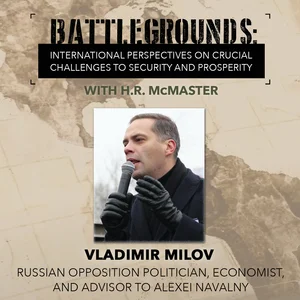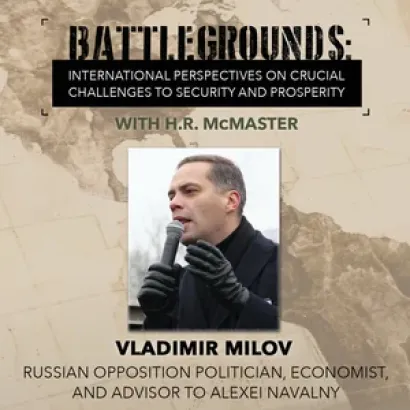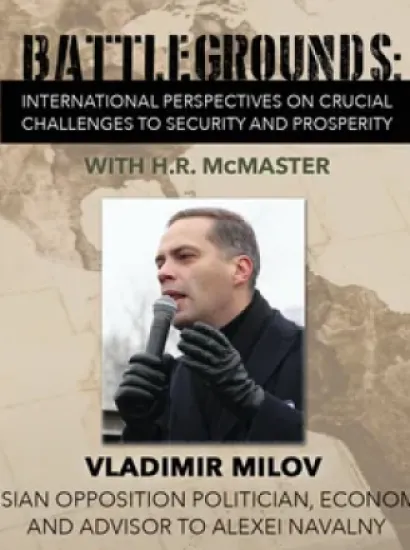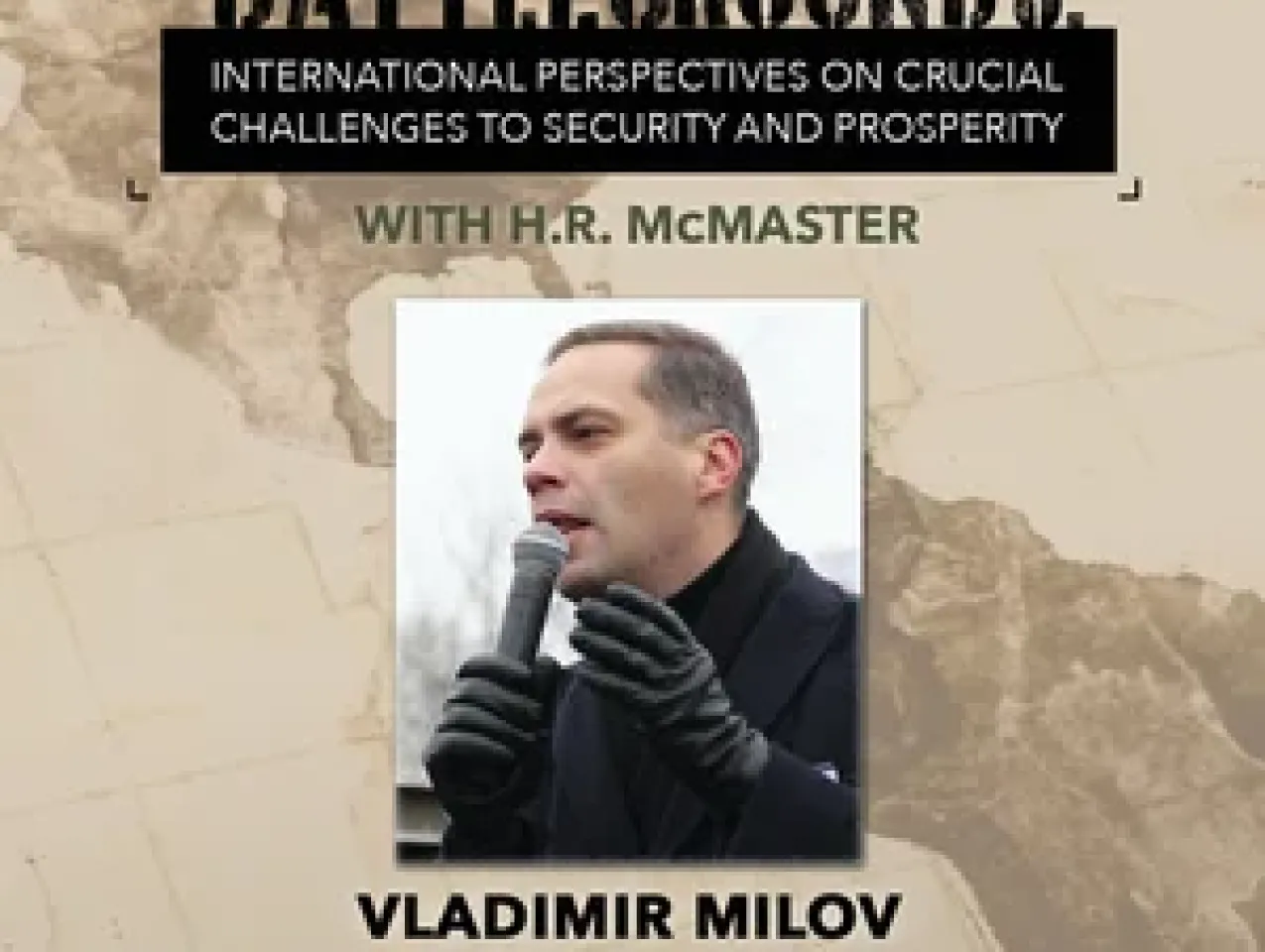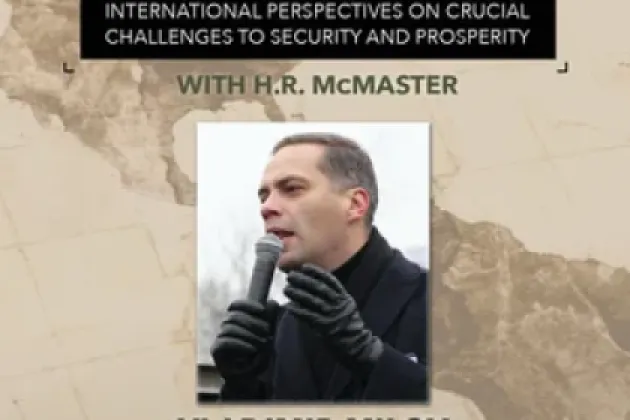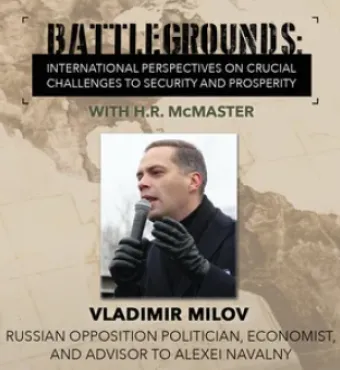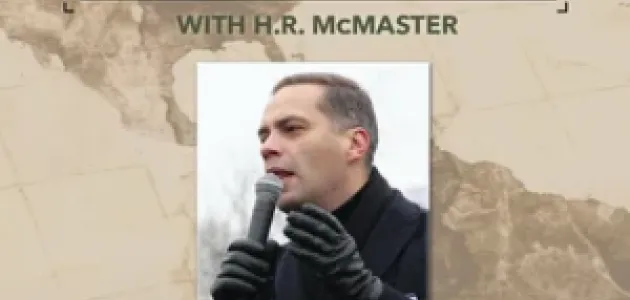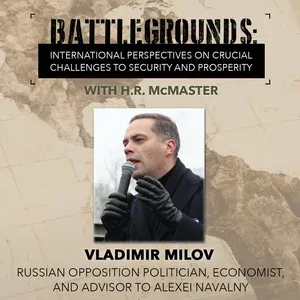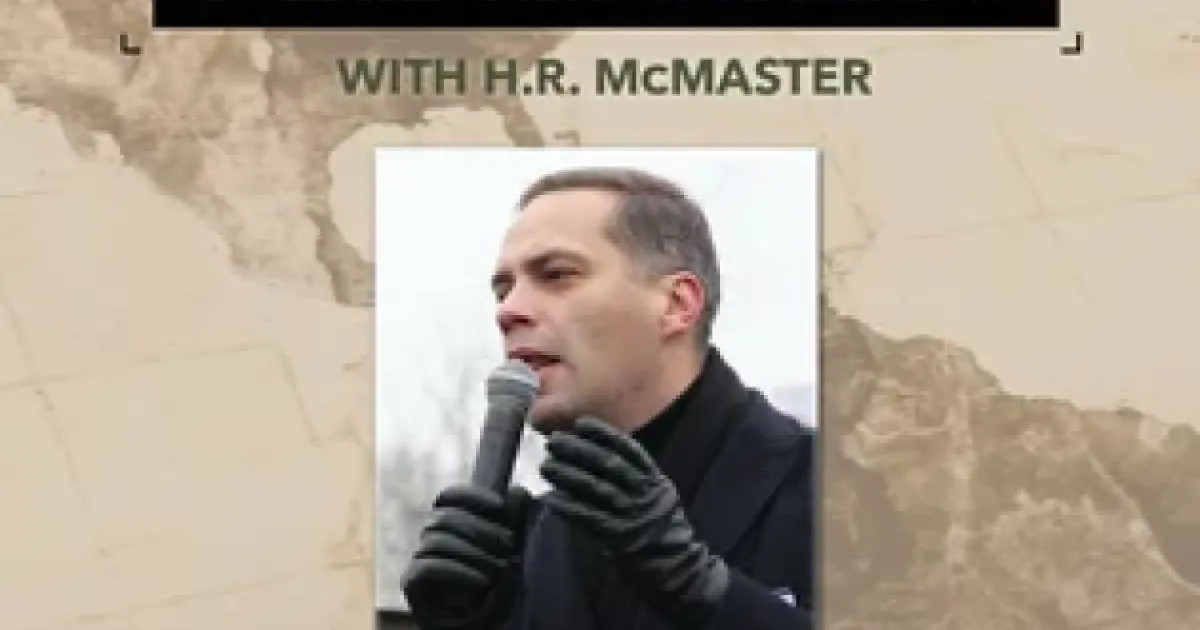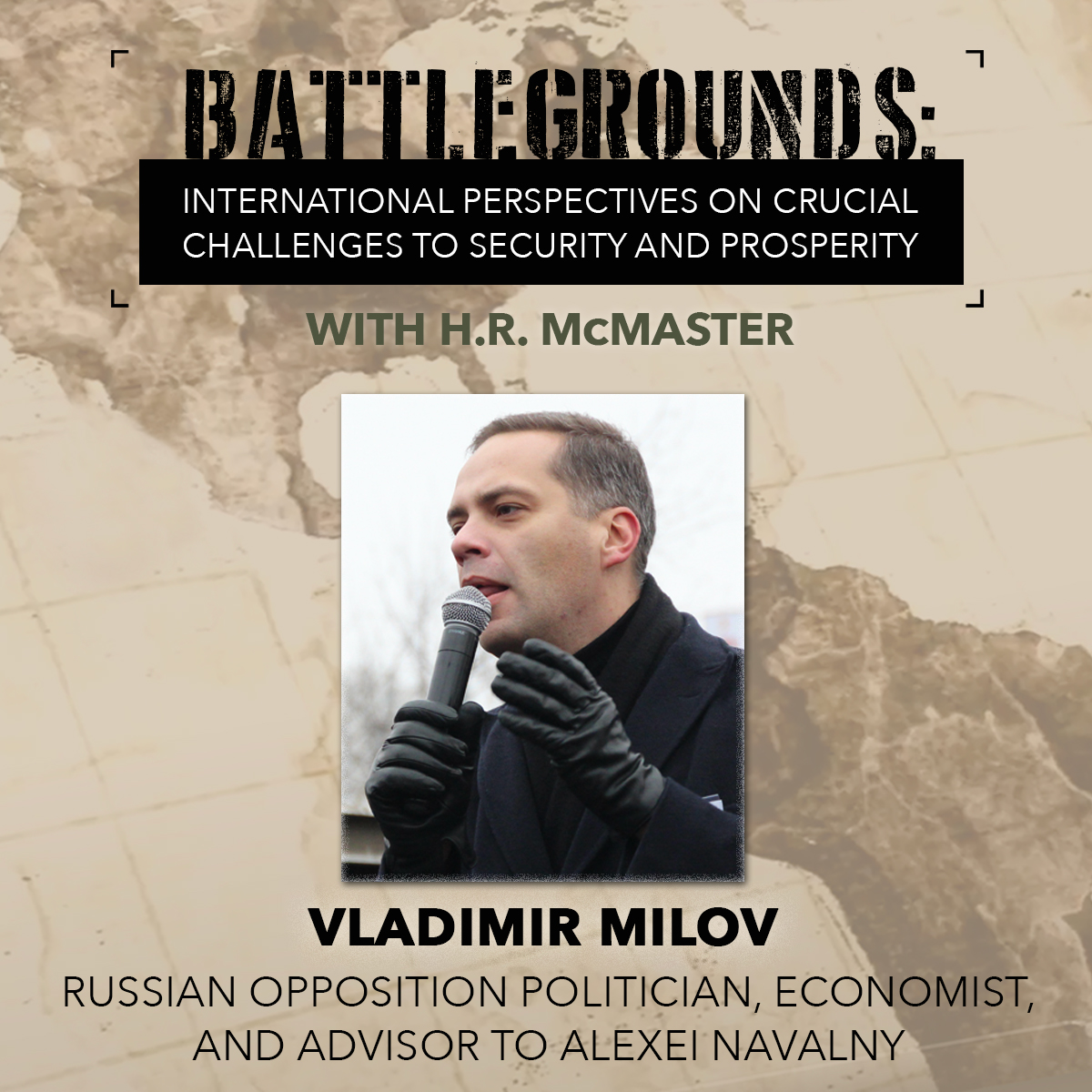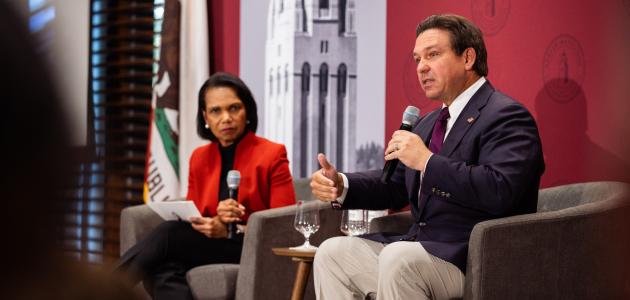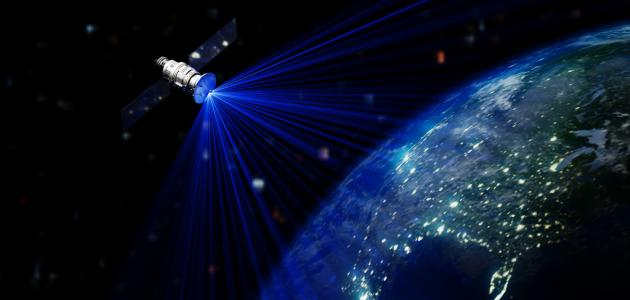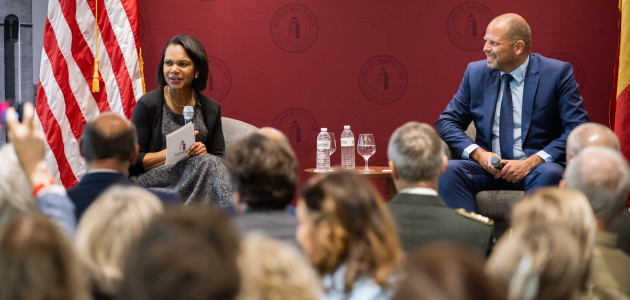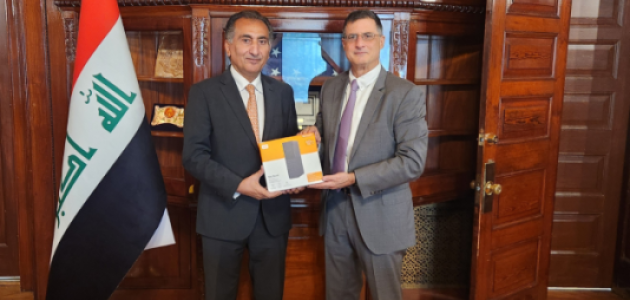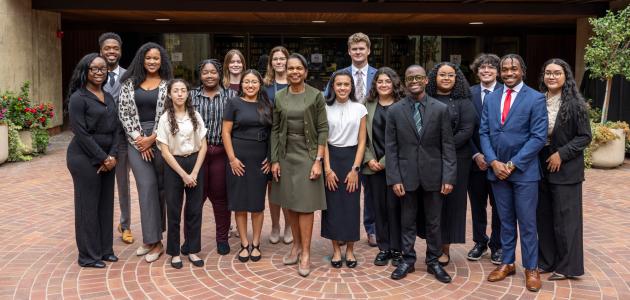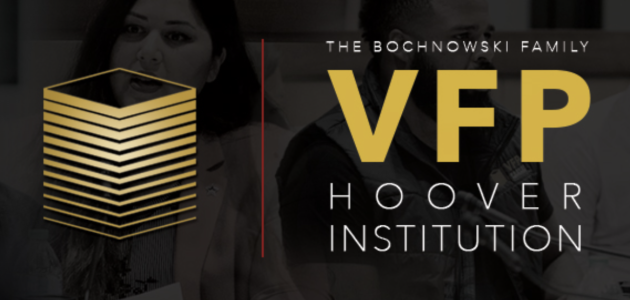In the latest episode of Battlegrounds, Vladimir Milov, economist and advisor to jailed Russian opposition leader Alexei Navalny, describes to Fouad and Michelle Ajami Senior Fellow H. R. McMaster the conditions in post–Cold War Russia that led to the rise of Vladimir Putin; how Putin consolidated power and established autocracy; and why the Kremlin decided to impose an aggressive nationalist agenda and foreign policy.
Milov was just seventeen in 1989, when the Soviet order began to collapse in Central and Eastern Europe. In June of that year, the Solidarity and the United Workers’ Party formed a governing coalition to end the Communists’ four decades of rule over Poland; by November, the Berlin Wall that had divided East and West Germany fell; and by Christmas, Nicolae Ceausescu’s government in Romania collapsed and the Velvet Revolution, a nationwide protest movement in Czechoslovakia, was ushering in a peaceful transition to a liberal government. The momentum of these events helped precipitate the dissolution of the Soviet Union at the end of 1991.
Milov explains that although Russia couldn’t consolidate the democratic gains it made during the decade that followed the end of the Cold War, its people have acquired enough experience with freedom that will be useful in the post-Putin era.
“It was a pretty chaotic time, but also a time of freedom and a time of hope,” Milov remembers about the decade of the 1990s. “Believe it or not, when Putin arrived as president in 2000, there was no idea among the majority of us that we would ever slide back to authoritarianism.”
This regression was a gradual process. After President Boris Yeltsin stepped aside at the end of 1999 and then prime minister Vladimir Putin assumed the position as acting president, characteristics of a healthy and well-functioning democracy began to be stripped away—including a strong independent judiciary and free and uncensored press. A key turning point took place in December 2001, when two rival Duma parties, United and Fatherland, merged to form United Russia and threw their support behind Putin.
“[United and Fatherland] had the same imperial, revanchist agenda. They wanted to centralize control over the economy and major assets and financial flows. They wanted to restore centralized government,” Milov describes. “Since [2001] they won supermajorities in parliament, and dictatorship was signed and sealed.”
Milov explains that for Putin, the spike in global oil prices in the mid-2000s aligned fortuitously with his pursuit of power. He had flirted with major reforms of the economy in the early 2000s, when oil prices were cheap. But because the world’s third-largest petroleum producer was reaping windfall profits, Putin had no incentive to decentralize state power over this major sector of the economy.
“This newly accumulated oil wealth unleashed [the Kremlin’s] imperial ideas, which were contained by the economic weakness of Russia,” recalls Milov, who served as Russia’s deputy energy minister in the early 2000s.
Despite that the overwhelming majority of Russians have never accepted dismantling democratic institutions, they were apathetic to the Kremlin’s power grab, in part because they too were enjoying unprecedented rates of economic prosperity. Milov said that in the first eight years of Putin’s reign, Russia’s annual average GDP growth was 7 percent and its average growth over real disposable income was 12 percent. Since 2008, however, Russia was no longer experiencing substantial rates of income growth.
Milov believes that fears of uprisings from his own people during the prolonged period of economic stagnation that followed is what ultimately motivated Putin to become more aggressive against Russia’s neighbors. From Moscow, Putin perceived democratic “color revolutions,” of the types in Georgia in 2003–4 and Ukraine in 2004, as existential threats to his autocratic style of rule and the concept of an imperial Russia.
In 2008, Russian troops invaded Georgia’s South Ossetia region, supporting separatists in their ambition to create a breakaway state. In early 2014, after demonstrations in Kyiv forced Russia-backed Viktor Yanukovych to abdicate the presidency of Ukraine, Putin annexed the Crimean Peninsula and supported pro-Russian forces in Ukraine’s eastern Donetsk and Luhansk regions. The conflicts in Donetsk and Luhansk have been continuous for the past eight years, and Putin exploited the regions’ tensions with Kyiv as his rationale to launch war on the whole of Ukraine in February 2022.
“Putin understood a long time ago, there will come a moment when the Russian people also claim freedom, [similar to] the people of Ukraine, Georgia, Moldova, and [other countries surrounding Russia],” says Milov. “He knows that. Which is why all that he has been doing in the past few years is doubling down on censorship [and] doubling down on repression. We now have two and a half times more official political prisoners then during the times of Brezhnev and Andropov.”
Milov doesn’t believe that NATO expansion, as the popular political scientist John Mearsheimer has charged, antagonized Putin into invading Ukraine. Rather, the situation might have been more peaceful today had Ukraine joined the defense treaty. Milov explains that in his conversations with Russian reform-minded politicians two decades ago, they insisted that Ukraine’s membership would have promoted greater political stability in that country. Accordingly, if Ukrainians were more confident in their security, they would have forged stronger trade and diplomatic relations with Russia.
Milov argues that Putin’s decision to invade Ukraine was based on two principal factors: 1) he exhausted political options and a variety of subversion tactics below the threshold of war to usher in pro-Russian leadership in Kyiv; and 2) he believed that the West was weak and would offer only a tepid response to conventional Russian military aggression.
Putin miscalculated, Milov contends, because he underestimated the Ukrainian people’s will to resist. Moreover, he asserts that the Russian army—mired in corruption and inefficiently operated—could only have been immediately victorious if Ukrainians outright fled their country. Milov explains that although the Kremlin touts its annual defense expenditures of 3 percent of GDP, most of those funds enrich a noncompetitive defense industry instead of bolstering Russian forces.
Consequently, Milov argues, the Kremlin’s defense policies have resulted in the production of low-quality weapons and a Russian army that is underpaid, underequipped, declining in morale, and currently losing in battlefields across Ukraine.
“Many of the real combat-ready forces have been decimated during the first few weeks of the campaign, so Putin can only continue to bombard Ukrainian cities. He cannot advance. At some point he will have to concede defeat in his initial plan to capture major Ukrainian cities and most of Ukrainian territory,” Milov explains. “What happens then? History tells us that significant military defeats basically lead to turbulent domestic political events.”
WATCH THIS EPISODE







